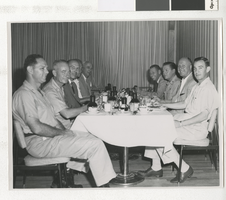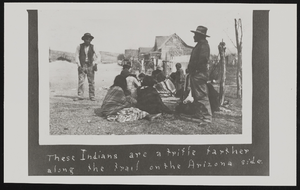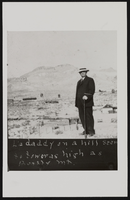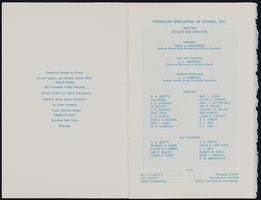Search the Special Collections and Archives Portal
Search Results
Las Vegas and Tonopah Railroad Blueprints
Identifier
Abstract
The Las Vegas and Tonopah Railroad Blueprints consists of twenty-four of the original thirty blueprints as part of the Interstate Commerce Commission (I.C.C.) Valuation Index Section I. They are labeled "Right-of-Way & Track Map, Las Vegas & Tonopah Railroad" and dated June 30, 1915. The blueprints contain four miles of railroad lines per sheet with a scale of 6 3/4 inches per mile. The collection also includes one sheet from the Bullfrog Goldfield Railroad company, which used the track, yard, and facilities of the Las Vegas and Tonopah and Railroad company between Beatty and Goldfield, Nevada.
Archival Collection

Photograph of business executives and Air Force officers, Las Vegas (Nev.), circa 1960
Date
Archival Collection
Description
Image

Native Americans along a trail: photographic print
Date
Archival Collection
Description
Image
Allison Henderson oral history interview, 2013 March 13
Level of Description
Scope and Contents
Henderson became an EMT in 1991 while working at a medical clinic in Beatty, Nevada.
Archival Collection
Archival Component

Lorraine Perry's father: photographic print
Date
Archival Collection
Description
Image
Nevada Mining Photograph Collection
Identifier
Abstract
The Nevada Mining Photograph Collection depicts mining activities, miners, and mining towns in Nevada from 1868 to 1937. The photographs primarily depict the towns of Tonopah, Nevada and Goldfield, Nevada, including mills, buildings, mine shafts, and panoramic views of the landscape. The photographs also depict Beatty, Lost City, Delamar, Candelaria, Winnemucca, Virginia City, Rhyolite, Elko, and Reno, Nevada. The photographs also include portraits of early settlers in Nevada, Native Americans, children, parades, celebrations, and funerals.
Archival Collection
Ida Pinckney oral history interviews
Identifier
Abstract
Oral history interviews with Ida Pinckney conducted by Claytee D. White on August 23, 2012 and November 05, 2012 for the African Americans in Las Vegas: a Collaborative Oral History Project. In this interview, Pinckney discusses her personal history and life in Las Vegas, Nevada after moving there with her family as a child in 1942. She begins by talking about her family and living in a tent house in the Westside community of Las Vegas. Pinckney describes how she feels Westside development has been stunted by an overabundance of churches in the area not paying taxes, life in the Westside during the 1940s, and her experiences as an African American woman in Las Vegas. Other topics of discussion include Pinckney being a member of Culinary Workers Union Local 226, her father and brother working at the Nevada Test Site, and various aspects of Las Vegas history. Willie Jean Beatty also participates in the interview, helping Pinckney expand on topics such as the presence of organized crime in casinos and her involvement in the Sisters Network: An Afro-American Breast Cancer Survivors Organization.
Archival Collection


